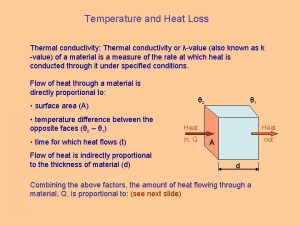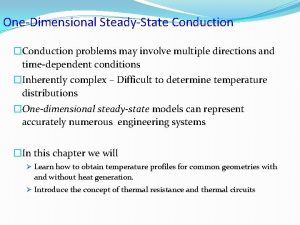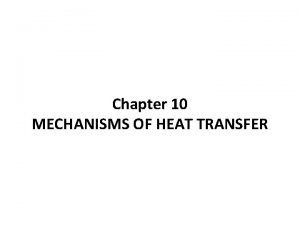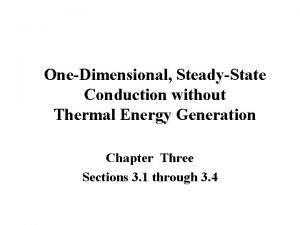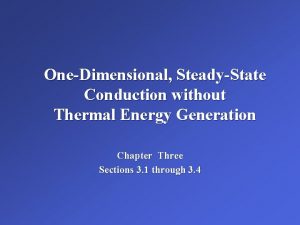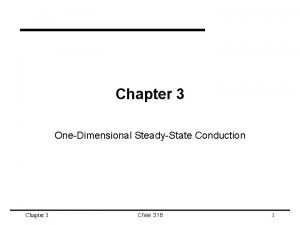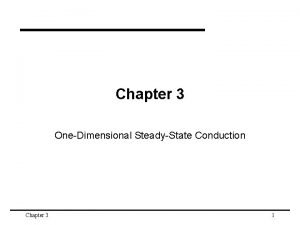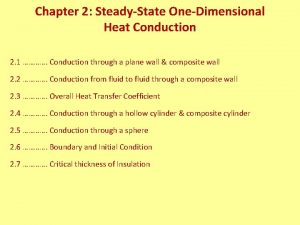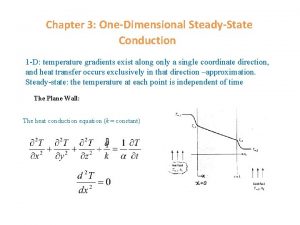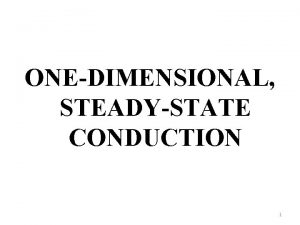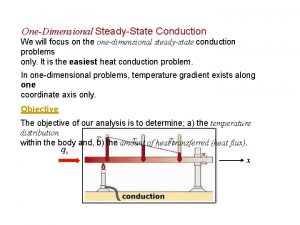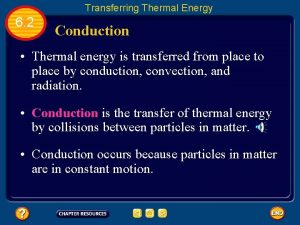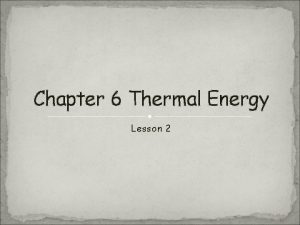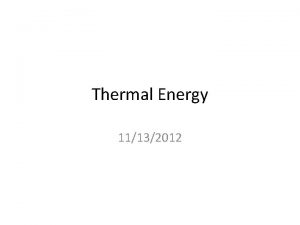OneDimensional SteadyState Conduction without Thermal Energy Generation Chapter












![Tube Wall (cont. ) • • Heat Flux and Heat Rate: [W/m 2] Heat Tube Wall (cont. ) • • Heat Flux and Heat Rate: [W/m 2] Heat](https://slidetodoc.com/presentation_image_h2/5a6e46d4d11792ec43f4941bdb3866a7/image-13.jpg)





- Slides: 18

One-Dimensional, Steady-State Conduction without Thermal Energy Generation Chapter Three Sections 3. 1 through 3. 4

The Plane Wall • Consider a plane wall between two fluids of different temperature: • Heat Equation: (3. 1) • Implications: • Boundary Conditions: • Temperature Distribution for Constant This is the SS solution, so there is no change in time. But it is a second order equation in x. This means we need two boundary conditions to solve it. : But how to we get here? (3. 3)

Thermal Resistance Model

Thermal Resistance Model

Thermal Resistance Model

Thermal Resistance Model • Thermal Resistance Over a Unit Surface Area (Conduction and Convection): • Radiation Resistance (Total, and Over Area): (1. 9)

Plane Wall (cont. ) • Composite Wall with Negligible Contact Resistance: (3. 14) For the temperature distribution shown, k. A > k. B < k. C. • ΔT For Individual Sections: Since q through material is a constant, we can find the temperature change over any section by:

Plane Wall (cont. ) (3. 14) • Overall Heat Transfer Coefficient (U) : A modified form of Newton’s law of cooling to encompass multiple resistances to heat transfer. (3. 17) (3. 19)

Plane Wall (cont. ) • • Series – Parallel Composite Wall: Circuits based on assumption of isothermal surfaces normal to x direction or adiabatic surfaces parallel to x direction provide approximations for. Assuming isothermal surfaces perpendicular to x-direction. Assuming adiabatic surfaces parallel to x-direction. • Note departure from one-dimensional conditions for .

Tube Wall The Cylindrical Wall

Tube Wall • The Cylindrical Wall Heat Equation: (3. 28) • Temperature Distribution for Constant : (3. 31)

Tube Wall The Cylindrical Wall
![Tube Wall cont Heat Flux and Heat Rate Wm 2 Heat Tube Wall (cont. ) • • Heat Flux and Heat Rate: [W/m 2] Heat](https://slidetodoc.com/presentation_image_h2/5a6e46d4d11792ec43f4941bdb3866a7/image-13.jpg)
Tube Wall (cont. ) • • Heat Flux and Heat Rate: [W/m 2] Heat flux (per unit area) [W/m] Heat loss over a unit length [W] Heat rate Conduction Resistance: (3. 33) Resistance over a unit length Why doesn’t a surface area appear in the expressions for thermal resistance?

Tube Wall (cont. ) • Composite Wall with Negligible Contact Resistance (3. 35) For the temperature distribution shown, k. A > k. B > k. C. but U itself is tied to specification of an interface. (3. 37)

Problem: Thermal Barrier Coating Problem 3. 23: Assessment of thermal barrier coating (TBC) for protection of turbine blades. Determine maximum blade temperature with and without TBC. SCHEMATIC:

Problem: Thermal Barrier Coating (cont. ) ANALYSIS: For a unit area, the total thermal resistance with the TBC is With a heat flux of the inner and outer surface temperatures of the Inconel are Inner surface temperature Outer surface temperature

Problem: Thermal Barrier Coating (cont. ) Without the TBC, Inner surface temperature Outer surface temperature

Problem: Heat Loss Through Window You have a double pane window that is 1 [m] x 1. 5 [m]. The glass is 4 [mm] thick with kglass = 0. 78 [W/m-K]. Between the panes is an air gap of 5 [mm], with kair = 0. 025 [W/m-K]. The outside air temperature is -20 °C with a convection coefficient of houtside= 20 [W/m 2 -K]. The inside air temperature is 20 °C with a convection coefficient of hinside= 40 [W/m 2 -K]. • • • Draw thermal resistance circuit for this system Calculate the heat rate through the window Calculate the change in temperature across each section
 Chapter 5 thermal energy answer key
Chapter 5 thermal energy answer key Transfer function steady state error
Transfer function steady state error Steady-state error
Steady-state error During conduction, thermal energy is transferred
During conduction, thermal energy is transferred Total thermal conductivity
Total thermal conductivity Steady state heat conduction
Steady state heat conduction Critical radius of insulation for cylinder
Critical radius of insulation for cylinder Thermal conduction resistance
Thermal conduction resistance Heat tr
Heat tr How are thermal energy and temperature different
How are thermal energy and temperature different Mass and thermal energy
Mass and thermal energy Thermal transfer vs direct thermal printing
Thermal transfer vs direct thermal printing First generation antipsychotics
First generation antipsychotics Lord you are good and your mercy is forever
Lord you are good and your mercy is forever Chapter 12 study guide thermal energy
Chapter 12 study guide thermal energy Chapter 12 thermal energy answers
Chapter 12 thermal energy answers Chapter 16 thermal energy and heat
Chapter 16 thermal energy and heat Mass and thermal energy
Mass and thermal energy Mining frequent patterns without candidate generation
Mining frequent patterns without candidate generation




